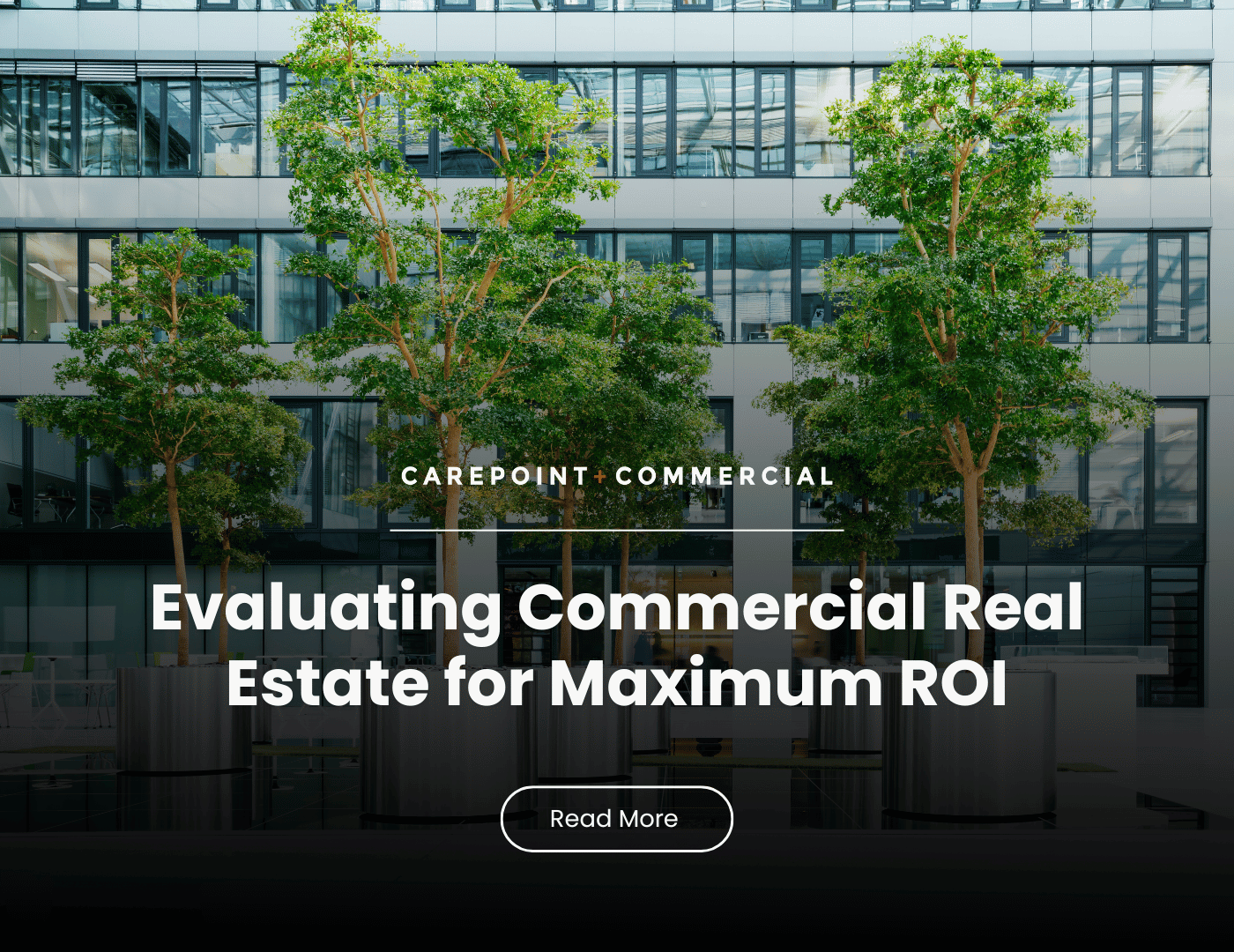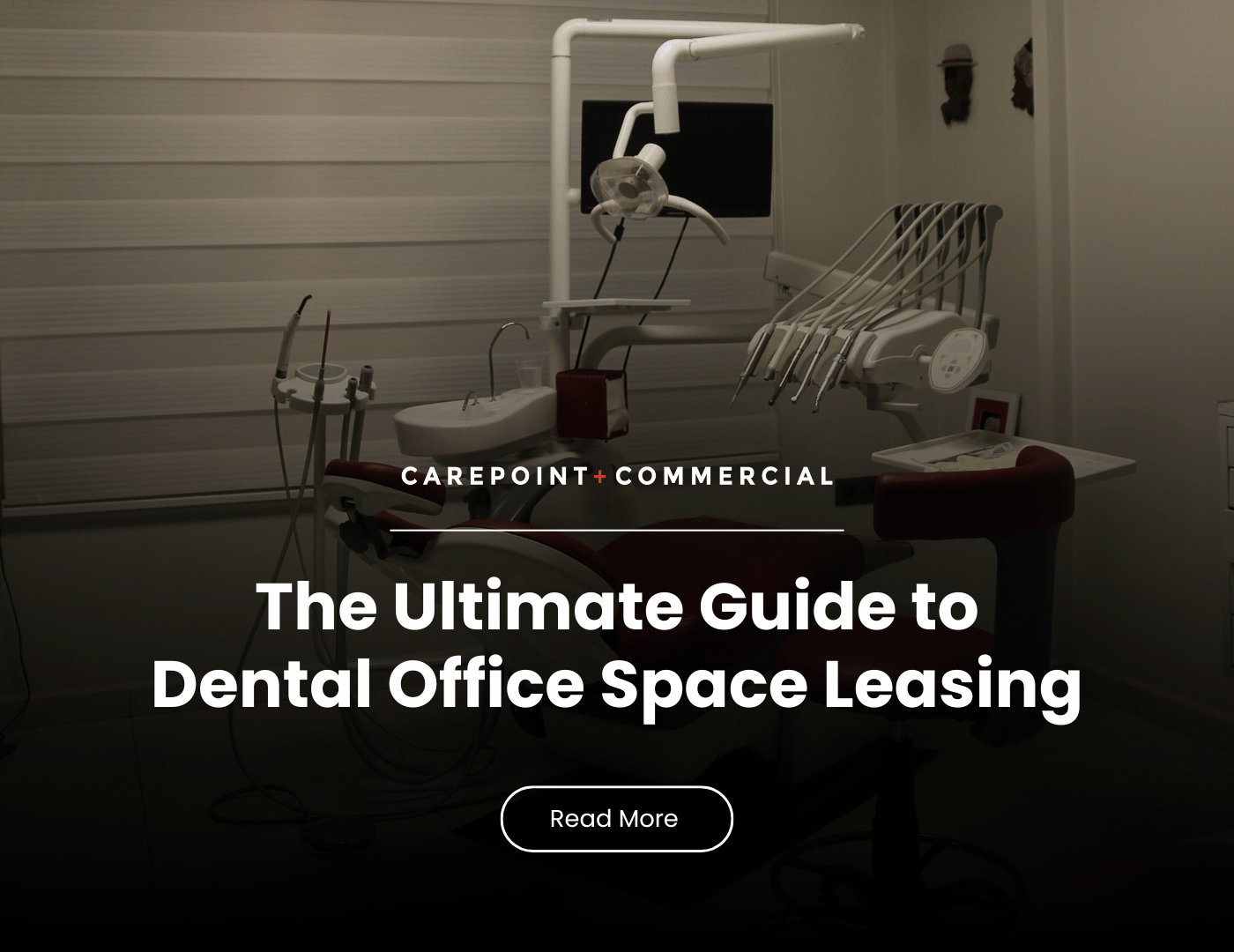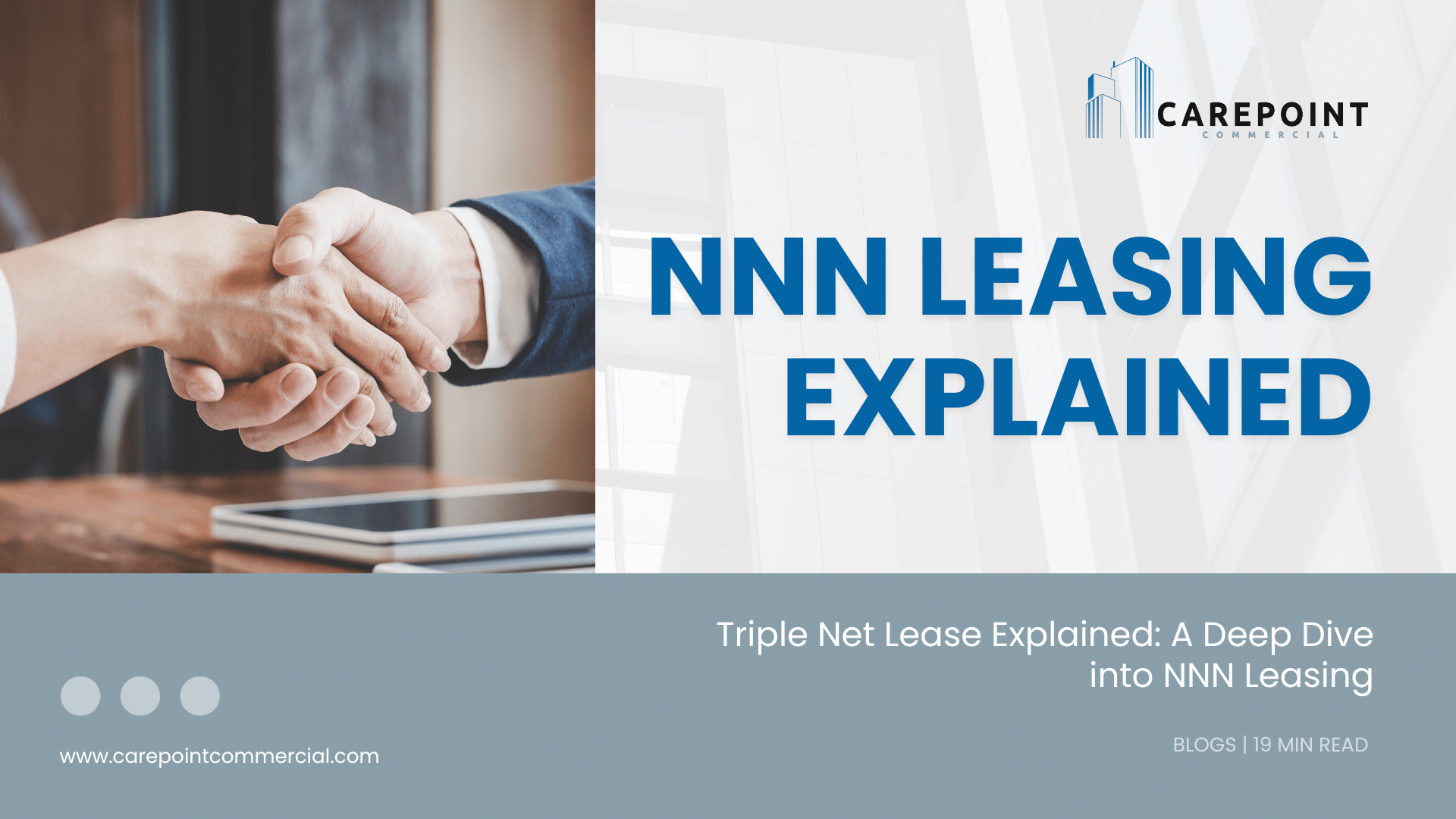Investing in Healthcare Real Estate: A Beginner's Guide
Healthcare real estate is a specialized sector that focuses on properties used for medical services, including hospitals, outpatient centers, and...
12 min read
![]() CarePoint Commercial Marketing
:
Jul 4, 2024 12:14:31 PM
CarePoint Commercial Marketing
:
Jul 4, 2024 12:14:31 PM

Commercial real estate (CRE) is a vital sector in the property market, covering office buildings, retail spaces, industrial properties, hotels, and multifamily housing. Unlike residential real estate, CRE generates income through leasing or sales to businesses and investors. Understanding the different types of CRE is crucial for anyone interested in investing, leasing, or managing these properties. This blog will explore the various aspects of CRE, providing insights to help you make informed decisions in this dynamic market.
TL;DR: Commercial real estate (CRE) encompasses various property types used for business purposes, including office buildings, retail spaces, industrial properties, hotels, and multifamily housing. CRE generates income through leasing or selling to businesses or investors. Understanding these different types is crucial for making informed investment, leasing, or management decisions.
Commercial real estate (CRE) refers to properties used for business purposes. It includes office buildings, retail spaces, industrial properties, hotels, and multifamily housing. Unlike residential real estate, CRE generates income through leasing or selling to businesses or investors. Understanding different types of CRE is essential for anyone looking to invest, lease, or manage these properties.
Office buildings provide workspaces for businesses, ranging from single-tenant buildings to skyscrapers with multiple businesses. These are classified into Classes A, B, and C, with Class A offering the best construction, location, and amenities. Class B and C buildings are older or in less desirable areas but can still be profitable due to lower prices and renovation potential.
Retail spaces include shopping centers, malls, strip malls, and standalone stores. These properties attract consumer traffic and are typically located in high-visibility areas to maximize sales. The success of retail properties depends on location, tenant mix, and the surrounding demographic. High-traffic areas with a strong customer base can drive significant revenue for tenants.
Industrial properties include warehouses, distribution centers, manufacturing plants, and research facilities. These properties are essential for businesses involved in production, storage, and distribution. Key factors include proximity to transportation hubs, accessibility, and zoning regulations. The rise of online shopping has increased the demand for warehouse space, making industrial properties highly valuable.
Hotels and resorts in the hospitality sector generate income by providing lodging, dining, and entertainment services. The success of these properties depends on location, brand reputation, amenities, and management quality. Hotels in prime locations can command high rates and achieve strong occupancy levels.
Multifamily housing units provide residential accommodations in buildings with multiple units, such as apartment buildings and condominiums. These properties generate income through rental payments and are seen as stable investments due to the consistent demand for housing. Investors benefit from economies of scale, making management more efficient and cost-effective.
Commercial real estate includes various property types serving different business purposes and investment opportunities. Understanding the characteristics and market dynamics of each type is crucial for successful investment and management in CRE. Whether you're an investor, tenant, or property manager, knowledge of CRE helps you make informed decisions and capitalize on diverse opportunities.
Investing in commercial real estate (CRE) offers several advantages, making it appealing for portfolio diversification and long-term growth. CRE generally provides higher rental yields compared to residential properties, as businesses are willing to pay more for prime locations and high-quality spaces, resulting in significant rental income. Office buildings in central business districts or retail spaces in high-traffic areas command substantial rents, and longer-term leases provide steady and predictable income.
Commercial real estate includes various property types such as office buildings, retail spaces, industrial warehouses, and multifamily housing units. This diversity allows investors to spread risk across different sectors and property types. Economic downturns affect residential and commercial markets differently, and within CRE, different sectors respond differently to market changes. Diversifying investments across multiple commercial property types mitigates risks and stabilizes portfolio performance.
Over time, commercial properties tend to appreciate due to inflation, market demand, and property improvements. Strategic location selection and property enhancements can significantly boost property value. For instance, an office building in an emerging business district or a retail space in a developing neighborhood can appreciate substantially. Investors can actively increase property value through renovations, better management, and lease agreements with high-quality tenants.
Commercial real estate also offers tax benefits such as deductions for depreciation, mortgage interest, property taxes, and maintenance costs. Depreciation allows investors to deduct a portion of the property's value each year, reducing taxable income. Additionally, the 1031 exchange provision in the U.S. tax code allows deferring capital gains taxes when reinvesting proceeds from a property sale into another qualifying property. These tax benefits enhance the overall profitability of CRE investments.
Leverage opportunities make CRE investments particularly appealing. Investors can use financing to purchase commercial properties, controlling valuable assets with relatively little capital. This leverage can amplify returns, as rental income and property appreciation often exceed borrowing costs. Commercial loans often have favorable terms, such as lower interest rates and longer repayment periods, further enhancing investment returns. Effective use of leverage allows investors to expand their portfolios and increase potential wealth.
Evaluating commercial real estate listings is crucial for informed investment decisions, ensuring properties align with investment goals, offer potential for appreciation, and generate stable income. Location significantly impacts a property's value, desirability, and income potential. Properties in high-traffic areas, near transportation hubs, and in growing neighborhoods attract more tenants and command higher rents. Proximity to businesses and services like banks, restaurants, and public transport enhances appeal. Conduct a market analysis of the area, considering demographic trends and economic forecasts, to assess the long-term viability of the location.
Inspect the property's physical condition, including structural integrity, plumbing, electrical systems, and HVAC units. Older buildings may require costly renovations to meet current codes and tenant expectations, while newer properties typically need less maintenance and attract higher-quality tenants. Check for environmental issues, such as asbestos or lead paint, which can pose health risks and lead to expensive remediation. Analyze the property's current and projected income, expenses, and net operating income (NOI) to gauge its financial health. Review rent rolls, lease agreements, and occupancy rates to determine income stability. Assess the potential for rent increases or property improvements that could add value. Calculate the capitalization rate (cap rate) and compare it to similar properties in the area to evaluate potential returns.
Understand the terms of existing leases, including duration, rent escalation clauses, and tenant responsibilities, as they impact cash flow and property value. Long-term leases with stable tenants provide predictable income, while short-term leases offer flexibility but come with higher vacancy risks. Analyze the tenant mix and business stability to understand the property's risk profile. Diverse tenant mixes from various industries generally offer more resilience to economic fluctuations. Consider the property's future growth potential in areas with planned infrastructure improvements, new developments, or favorable zoning changes.
These factors can lead to significant appreciation. Stay informed about local government plans and real estate trends to identify properties with strong growth potential. Properties with flexibility for reconfiguration or expansion can offer opportunities to increase rental income and value over time.
Leasing commercial space is a significant decision that can impact your business's success and growth. Whether you're a startup looking for your first office or an established company seeking to expand, understanding key factors is essential for an informed leasing decision.
Location is paramount. The location of your commercial space affects your business's visibility, accessibility, and overall success. Retail businesses should look for high-traffic areas with good foot traffic, while office-based businesses might prioritize proximity to clients, suppliers, or transportation hubs. Industrial businesses may focus on access to highways and transportation routes. Also, consider the neighborhood's demographics and economic health, as these factors can impact your business's growth and customer base.
Lease terms and conditions are critical. Carefully review the lease agreement to understand the terms, including the length of the lease, rent escalation clauses, and renewal options. Negotiate terms that provide flexibility and protect your business interests. For instance, consider a lease with options to renew or expand your space as your business grows. Pay attention to rent increase clauses, as these can affect your long-term financial planning. Ensure the lease clearly outlines responsibilities for maintenance, repairs, and improvements to avoid unexpected costs.
Space and layout requirements are vital. Assess your current and future space needs to ensure the commercial space can accommodate your business operations. Consider the layout and whether it supports your workflow and operational efficiency. An open floor plan might suit collaborative work environments, while private offices are essential for client meetings and confidential work. Additionally, evaluate the potential for customization or modifications to the space to suit your specific needs. Ensure the space meets all regulatory requirements, including accessibility standards and safety codes.
Understanding the costs associated with leasing commercial space is crucial for effective budgeting and financial planning. Beyond the base rent, consider additional costs such as utilities, property taxes, insurance, and common area maintenance (CAM) fees. These costs can significantly impact your overall budget, so it's important to get a clear picture of all expenses involved. Additionally, factor in potential costs for renovations or improvements to make the space suitable for your business. Budget for potential rent increases over the lease term and assess whether the space offers good value for the rent charged.
Consider the landlord and property management. A responsive and cooperative landlord can make a significant difference in your leasing experience. Research the landlord's reputation and track record with other tenants. Good property management ensures the building is well-maintained, issues are promptly addressed, and communication is clear and effective. Establishing a positive relationship with your landlord can lead to better lease negotiations and a more supportive environment for your business.
Navigating the commercial real estate market can be complex, especially for newcomers. Understanding its fundamentals is crucial for making informed decisions, whether you're an investor, a business owner looking to lease space, or a real estate professional. This overview covers the key elements of the commercial real estate market, helping you make strategic and beneficial choices.
First, the commercial real estate market is diverse, segmented into various property types serving different purposes and industries. These include office buildings, retail spaces, industrial properties, multifamily housing units, and specialized properties like hotels and healthcare facilities. Each segment has unique dynamics and drivers. For instance, office spaces depend on employment rates and business growth, retail spaces thrive in high-traffic areas with strong consumer spending, industrial properties are influenced by manufacturing trends and logistics needs, and multifamily housing is driven by population growth and urbanization.
Market trends and economic indicators significantly shape the commercial real estate landscape. Key indicators such as GDP growth, employment rates, consumer spending, and interest rates affect the demand and supply of commercial properties. During economic expansion, businesses expand and lease more office space, retail sales increase, and the demand for logistics and warehouse space grows. Conversely, during downturns, vacancy rates may rise, and rental rates can decline. Monitoring these indicators helps investors and business owners anticipate market movements and make informed decisions.
Furthermore, Location is another critical factor. The desirability and value of commercial properties are heavily influenced by their location. Prime locations with high visibility, accessibility, and proximity to other businesses and amenities command higher rents and property values. Local market conditions, such as zoning laws, infrastructure developments, and demographic trends, also play a crucial role. Properties in growing urban areas with robust infrastructure and favorable zoning laws tend to appreciate more and attract higher-quality tenants. Understanding these location-specific nuances provides a competitive edge in the market.
Leasing dynamics are also essential to the commercial real estate market. Lease terms, rental rates, and tenant mix impact the profitability and stability of commercial properties. Long-term leases with creditworthy tenants provide steady income and reduce vacancy risk, but they may limit rental rate adjustments in response to market changes. Short-term leases offer more flexibility but come with higher turnover risk. Balancing lease stability and flexibility is crucial for property owners and investors. Additionally, analyzing tenant mix and maintaining a diverse portfolio can mitigate risks associated with market fluctuations in specific industries.
Finally, investment strategies and market cycles are key components. Different strategies—such as value-add, core, core-plus, and opportunistic—cater to various risk appetites and return expectations. Understanding where the market stands in its cycle—whether in expansion, peak, contraction, or recovery—can inform your investment approach. During market expansion, investors might focus on properties with high-growth potential, while in contraction phases, they might prioritize assets with stable, long-term tenants. Awareness of market cycles helps investors time their acquisitions and dispositions to maximize returns.
Commercial real estate (CRE) includes various property types, each serving different business purposes and investment goals. Understanding these types is crucial for investors, tenants, and real estate professionals to make informed decisions and capitalize on market opportunities. Here's an overview of the main categories of CRE, highlighting their unique characteristics and potential benefits.
Office Buildings: Office buildings provide workspaces for businesses, from small professional offices to large corporate headquarters. They are typically classified into Class A, B, and C:
Class A: High-quality buildings in prime business districts with modern amenities and high-profile tenants.
Class B: Functional spaces at lower costs, often located in suburban areas or secondary business districts.
Class C: Older, less desirable properties that may require significant renovations.
Retail Spaces: Retail spaces include shopping centers, strip malls, individual storefronts, and larger complexes like malls and lifestyle centers. These properties are designed to attract consumer traffic and facilitate sales. High-visibility areas with strong foot traffic, such as downtown districts or major thoroughfares, are particularly desirable. Retail properties house various businesses, including restaurants, clothing stores, and service providers. The rise of e-commerce has led to the development of mixed-use properties combining retail with residential and entertainment spaces.
Industrial Properties: Industrial properties are essential for manufacturing, storage, and distribution activities. This category includes warehouses, distribution centers, manufacturing plants, and flex spaces combining office and industrial functions. Key factors driving industrial real estate include proximity to transportation networks, availability of large open spaces, and zoning regulations. The logistics and e-commerce boom has increased demand for warehouse and distribution space. Industrial properties are often located on the outskirts of cities or in industrial parks to accommodate large-scale operations and provide easy access to highways, railroads, and ports.
Multifamily Housing Units: Multifamily housing units, while often associated with residential real estate, are a significant component of CRE due to their income-generating potential. This category includes apartment complexes, condominiums, and co-living spaces providing housing for multiple tenants. Multifamily properties are attractive investments due to their steady rental income and resilience in economic downturns. Urbanization trends and the demand for affordable housing have driven the development of multifamily units, especially in metropolitan areas. Investors benefit from economies of scale, as managing multiple units within a single property can be more efficient than managing multiple single-family homes.
Specialized Properties: Specialized properties include a wide range of CRE types tailored to specific industries:
Hotels and Resorts: Catering to the hospitality industry, providing lodging and amenities for travelers and tourists.
Healthcare Facilities: Such as hospitals and medical office buildings serving the medical and wellness sectors.
Senior Living Centers: Offering residential care and services for elderly populations.
Self-Storage Units: Providing secure storage solutions for individuals and businesses.
Commercial real estate comprises various property types, including office buildings, retail spaces, industrial properties, multifamily housing units, and specialized properties. Each type serves distinct purposes and offers unique investment opportunities. Understanding the characteristics and market dynamics of these different types of CRE helps investors and real estate professionals make strategic decisions and capitalize on the diverse opportunities available. Whether investing, leasing, or managing commercial properties, a comprehensive understanding of the various property types is essential for success.
Finding the best commercial real estate for sale involves a strategic approach and thorough research. Whether you're an investor looking to expand your portfolio or a business owner seeking a new location, identifying the right property can significantly impact your financial success. Start by clearly defining your investment goals and criteria, considering factors such as property type (office, retail, industrial, multifamily), location, budget, and expected return on investment. Understanding your specific needs and objectives helps narrow down your options and focus your search on properties that align with your goals. Additionally, consider the long-term potential of the property, including future development plans and market trends in the area.
Utilize online real estate platforms like LoopNet, CoStar, and Zillow Commercial, which offer comprehensive databases of commercial properties for sale. These websites allow you to filter searches based on location, price range, property type, and size. Subscribing to alerts can keep you updated on new listings that match your preferences. While online platforms provide detailed information, including property descriptions, photos, floor plans, and market data, it's crucial to verify the accuracy of the information and conduct due diligence on any property of interest.
Engage with commercial real estate brokers to gain access to exclusive listings and professional insights. Brokers specialize in commercial properties and possess extensive knowledge of the local market. They can provide valuable information on available properties, market conditions, and pricing trends. Working with a broker can also give you access to off-market properties not publicly listed. Brokers can assist in negotiating purchase terms, conducting property inspections, and navigating the complexities of the buying process. Choosing a broker with a strong track record and expertise in the specific type of property you are interested in can enhance your search and increase your chances of finding the best deals.
Conduct thorough due diligence to evaluate the potential of each property. Analyze financial statements, lease agreements, property condition reports, and market comparables. Assess the property's income potential by reviewing rent rolls, occupancy rates, and tenant stability. Understand the expenses associated with the property, including maintenance, taxes, insurance, and any upcoming capital expenditures. A physical inspection of the property can help identify structural issues or necessary repairs. Additionally, review zoning regulations and potential legal issues that could impact the property's use and value.
Consider future growth and market trends to ensure the long-term viability of your investment. Research the economic outlook and development plans for the area where the property is located. Properties in growing neighborhoods with strong economic indicators and planned infrastructure improvements are likely to appreciate in value. Understanding demographic trends and consumer behavior can provide insights into the demand for different types of commercial properties. Investing in areas with high growth potential can lead to significant returns and long-term success.
Investing in commercial real estate (CRE) can be lucrative, but not all properties guarantee success. Identifying what makes a good commercial real estate investment involves evaluating several key factors that influence profitability and long-term value.
Location is paramount in evaluating CRE investments. A property's location significantly affects its income potential and value appreciation. Prime locations with high visibility, easy access, and proximity to transportation hubs, shopping centers, and residential areas tend to attract more tenants and command higher rents. Areas with strong economic growth, low crime rates, and robust infrastructure are likely to see increased property values over time. Conducting a thorough analysis of the neighborhood and local market conditions is essential to determine investment viability.
The quality and condition of the property also play a crucial role. Well-maintained, modern properties compliant with current building codes are more attractive to tenants and require less capital expenditure for repairs and upgrades. An in-depth inspection of the building’s structural integrity, HVAC systems, electrical wiring, and plumbing is vital. Properties with flexible layouts that can adapt to different tenants' needs are more likely to remain occupied, reducing vacancy rates and ensuring a steady income stream.
Tenant quality and lease terms are critical considerations. The financial stability and reliability of existing tenants significantly impact the property’s cash flow and overall value. Long-term leases with creditworthy tenants provide a predictable income stream and reduce the risk of vacancies. Reviewing current lease terms, including rent escalation clauses, renewal options, and tenant responsibilities for maintenance and repairs, is essential. Properties with a diverse tenant mix from various industries can mitigate the risk of economic downturns in specific sectors.
Financial metrics, such as the capitalization rate (cap rate), are essential for evaluating profitability. The cap rate is calculated by dividing the property’s net operating income (NOI) by its purchase price. A higher cap rate indicates a potentially higher return on investment but may come with increased risk. Investors should compare the cap rate with similar properties in the area to determine if the property is priced competitively. Understanding the property’s cash flow, debt service coverage ratio (DSCR), and return on investment (ROI) provides deeper insights into its financial performance and potential risks.
Future growth potential and market trends are vital for assessing a CRE investment. Properties in areas with planned infrastructure projects, new business developments, or favorable zoning changes are likely to appreciate in value. Monitoring demographic trends, such as population growth and shifts in consumer behavior, can help identify properties with high demand. For example, the rise of e-commerce has increased the demand for warehouse and distribution centers, making industrial properties in strategic locations highly sought after. Staying informed about market trends and economic indicators helps investors make proactive decisions and capitalize on emerging opportunities.
Successful commercial real estate investment depends on key factors: a prime location with good visibility and access, modern, well-maintained properties, stable tenants with favorable lease terms, competitive capitalization rates, and strong growth potential based on market trends and demographics. Thorough evaluation of these elements helps investors identify properties with strong income potential and long-term value, ensuring informed, strategic decisions in the commercial real estate market.

Healthcare real estate is a specialized sector that focuses on properties used for medical services, including hospitals, outpatient centers, and...

Leasing a dental office is a crucial decision that impacts your practice's success. Understanding the basics of leasing helps you make an informed...

The Triple Net Lease is a foundational component in commercial real estate, especially for healthcare professionals seeking the right space for their...